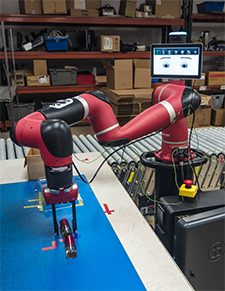DHL is testing two collaborative robots on co-packing and value-added tasks in its warehouses. The robots, called Baxter and Sawyer, have been working on a number of tasks, including: assembly, kitting, packaging and pre-retail services.
 The logistics company is piloting how to integrate the robots into a number of operational sites globally. DHL has already purchased its first Sawyer robot – its research involves 3D printing possibilities to generate specialised grippers for the robots, so other tasks can be completed in the warehouse.
The logistics company is piloting how to integrate the robots into a number of operational sites globally. DHL has already purchased its first Sawyer robot – its research involves 3D printing possibilities to generate specialised grippers for the robots, so other tasks can be completed in the warehouse.
“Historically, the distribution environment has been difficult to automate using traditional industrial robots, which do not respond well to variability,” says Matthias Heutger, SVP Strategy, marketing & innovation, DHL customer solutions & innovation. “In our recently published DHL Trend Report “Robotics in Logistics” we found that 80 per cent of logistics facilities today are still manual due to the complexity of the operations.
“As technology improves however, the logistics industry is benefitting from the adoption of collaborative robots to improve efficiency.”
Adrian Kumar, vice president of solutions design North America at DHL Supply Chain.
“Baxter and Sawyer robots are some of the most advanced collaborative robots on the market, and we plan to deploy them in a variety of packaging and inventory tasks that will allow us to use our employees for higher value work. By deploying these robots to work in tandem with humans, we can ensure our production lines are adjusting to changes and running more efficiently year-round.”






